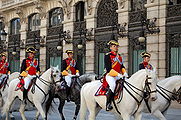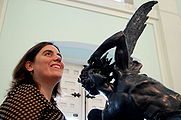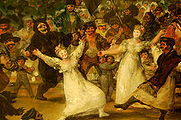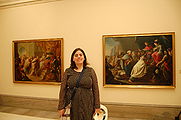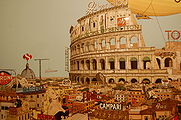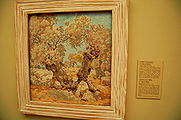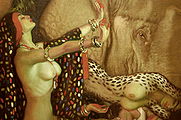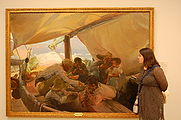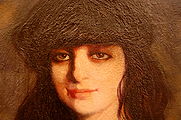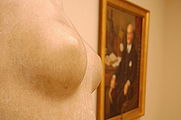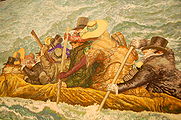Museo de la Real Academia de Bellas Artes de San Fernando
The Museo de la Real Academia de Bellas Artes de San Fernando is the top gallery of Madrid on the important-vs-famous scale. Here you can enjoy some major works in an essentially empty museum. With Goya as one of the directors and Picasso, Dalí and Botero as some of the alumni, the Academia is a testimony of Madrid's weight in the history of the fine arts. It has the most important Goya collection after el Prado.
At the beginning of the exhibition stands a polyester resin replica of the statue of the fallen angel, in el Retiro, which is a personal favorite. The proximity allows you to examine the details of Bellver's work, whose original perched at 666m prevents you to conduct a minute inspection from your 663m or so. You can appreciate for instance how a snake conceals the Devil's genitalia, that you would not see anyway, how the face gets horribly distorted when faced directly or how the many snakes devouring each others in fact all stem from a unique body.
The gallery itself contains works from Rubens, Fragonard, Van Loo, Murillo, Zurbarán, Sotomayor, Ribera, Juan Gris, Picasso and others equally famous or important. There is an excellent Guía del Museo (in Spanish) and a compilation of the main works from the museum itself or, even better, from Google (their mind boggling Google Cultural Institute).
I will only comment as little as time allows on the works themselves and let the gallery below give a larger overview of what caught my attention. Maybe what I found most striking was La degollación de los inocentes, by José Ginés, a collection of sculptures with 5950 pieces (existing or planned, I am not sure, but only a few are exposed), destined for a nativity-scene type of composition at the Palacio Real depicting the massacre of the innocents. Here the violence is overwhelming, the sheer rage of the women mixes with a total despair as they fight with their nails, their teeths, their entire body against men that are launched like irrational beasts onto babies that they stab, trample, decapitate. There are so many and so palpable contradictory human feelings, giving you a sense that the excesses, the madness, the distress of the human kind have always been the same, that it is difficult to carry on to the next room and have a look at other stories, of power, of peace and wars, of sensuality and sex, painted in a not so direct fashion.
Another particularly attractive work is "Buddha's temptations" (1921), by Eduardo Chicharro Agüera, a student of Sorolla, who painted the main weaknesses of man tempting Buddha as luscious women with heavy breasts, all differing in their forms and shapes, so that the realism and temptation are exacerbated. As these Apsaras (incarnation of evil) surround him in a variety of expressions, postures and styles of seduction, Buddha remains unperturbed and exclaims: "Mujeres, no sois más que sombras". The greenish glaze of the painting, the way the thematics is dealt with and just the overall look give it a Klimt touch that makes this huge painting noticeable among paintings from the greatest world and timeless artists.
The museum is on the Calle de Alcalá. On our way, we met these horsemen preparing for the parade of the levantamiento del 2 de mayo.
Copy of the fallen angel who is otherwise falling in el Retiro.
One of the major works from the museums: El entierro de la sardina from Goya, typical of the most daunting style of the master, with a freaking Donnie Darko like anachronistic figure.
Elena in the beautiful palace of the academy, that its members—previously hosted in la Casa de la Panederia of the Plaza Mayor—preferred so as not have dependencies and common walls with others.
Elena between two representations of the Catholic Monarchs receiving the embassy of the king of Fez. Left by Vicente López Portaña (1772-1850), right by Antonio Rodríguez (1765-1823), both from Valencia.
A satire of our society by Miguel Cuba Taboada, in the temporary exhibition.
Detail of the temptations of Buddha by Agüera. Here is lust, with the panther body, and Buddha's young and beautiful wife (Yasodharā) who is also part of the temptresses.
